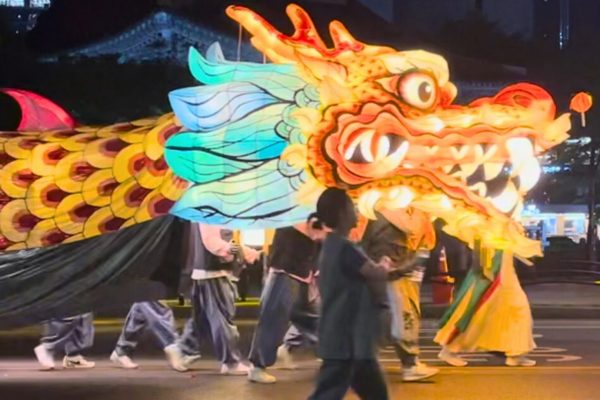Seollal (설날), South Korea’s Lunar New Year, is one of the most important holidays in Korean culture. Celebrated with family, traditional customs, and plenty of delicious food, it marks not just the beginning of the new lunar year but also a time to honor ancestors and set the tone for a prosperous year ahead. Whether you’re living in Korea, traveling during this festive season, or just curious about Korean culture, understanding Seollal offers a fascinating glimpse into the country’s rich traditions and values.
In this guide, you’ll learn everything from its history and customs to modern-day practices and even superstitions. And if you scroll all the way to the end, you’ll find a handy vocabulary guide for Seollal. Let’s dive in!

What is Seollal?
Seollal is Korea’s Lunar New Year, celebrated on the first day of the lunar calendar. While the specific date changes each year, it typically falls in late January or early February. Historically rooted in Confucianism and agricultural traditions, Seollal emphasizes family unity, ancestor worship, and starting the year afresh.
Unlike Western New Year’s Eve, which focuses on parties and resolutions, Seollal centers around family gatherings, honoring ancestors, and reflecting on the past while preparing for the future. It’s a deeply meaningful time when Koreans reconnect with their cultural heritage.
How is Seollal Celebrated?
Family Gatherings
For Seollal, families come together, often traveling great distances to their hometowns. It’s one of the busiest travel periods in South Korea, with highways, airports, and train stations buzzing with activity. This annual reunion strengthens family bonds and honors the tradition of respecting one’s roots.
Charye (차례)
A key part of Seollal is Charye, the ancestral rites performed to honor deceased family members. Families prepare a ceremonial table filled with specific dishes, including rice cakes, fruits, fish, and vegetables, all meticulously arranged. Each item on the table holds symbolic significance, such as wealth, health, and prosperity. The ceremony involves bowing and offering food to the spirits of ancestors.
Sebae (세배)
Sebae is a respectful bow performed by younger family members to their elders. This act symbolizes gratitude and a wish for blessings in the new year. In return, the elders offer words of wisdom and often gift Sebaetdon (세뱃돈), or “New Year’s money,” in small, colorful envelopes.
Food and Festivities
No Seollal is complete without Tteokguk (떡국), a savory soup made with sliced rice cakes. Eating Tteokguk is symbolic of gaining a year in age and is considered essential for welcoming the new year. Other dishes like jeon (savory pancakes) and galbi-jjim (braised short ribs) are also popular. After the formalities, families enjoy games like Yutnori (윷놀이), flying kites, or simply catching up. If you’re interested in Korean children’s games, you can find more information in this blog post.

Why is it Pronounced Seollal?
If you know how to read Hangeul, the pronunciation of “Seollal” (설날) can seem puzzling due to the differences between written Korean and how it’s spoken. You’d expect it to be pronounced “Seolnal,” which is quite a mouthful. So this is where the concept of batchim (받침), or final consonants, comes into play.
In Korean, the last consonant of a syllable often undergoes sound changes when followed by certain sounds. Some of these consonant assimilations have happened over time as they make it easier to pronounce certain words. These sound changes are a common feature of the Korean language, adding to its unique rhythm and flow.
Superstitions and Beliefs
The Night Before Seollal
Seollal’s magic begins on New Year’s Eve. According to tradition, people must stay vigilant as spirits are believed to roam the earth that night. One enduring superstition warns against sleeping early, as it’s thought to bring premature gray hair. Many families stay up together, engaging in games or storytelling, ensuring they’re wide awake to greet the new year properly.
Stealing Shoes
Another intriguing superstition revolves around shoes. On Seollal’s eve, it’s believed that spirits can steal your shoes, symbolizing bad luck taking away your path for the new year. To avoid this, people often keep their shoes hidden or inside the house.
Avoiding Black and White Clothes
Wearing black or white clothing during Seollal is considered inauspicious, as these colors are associated with funerals and mourning. Instead, people prefer wearing bright, colorful Seolbim (설빔; new year’s clothing) to symbolize positivity and good fortune in the year ahead.
Common New Year’s Superstitions
- Avoid crying or arguing, as it’s thought to set a negative tone for the year.
- Dreaming of pigs or dragons on Seollal is considered a sign of good fortune.
- Don’t sweep the floor, as it’s believed you might sweep away good luck.

Korean Age and Seollal
Traditionally, Koreans consider everyone to age collectively on Seollal, marking the start of a new year. This means that rather than celebrating individual birthdays, a person’s age increases by one on Lunar New Year. Eating Tteokguk is symbolic of this aging process. However, with the recent introduction of the international age system in South Korea, there’s been a shift toward recognizing birthdays individually as in Western cultures. Despite this change, the traditional age system remains an important cultural element, especially during Seollal.
Modern-Day Seollal
While traditional customs remain central to Seollal, modern lifestyles have introduced some changes. Urban families may simplify Charye rites, and younger generations often combine traditional celebrations with contemporary leisure activities. Seollal is also becoming more inclusive, with many non-Koreans living in South Korea participating in the festivities through community events and cultural programs.
Tips for Travelers
- Plan Ahead: Major cities like Seoul become quieter as residents leave for their hometowns. Many businesses may close, so research operating hours in advance.
- Embrace Cultural Events: Folk villages, museums, and palaces often host Seollal-themed performances, games, and food-tasting events—perfect for visitors!
- Be Respectful: If you’re invited to celebrate with a Korean family, follow their lead. Learn how to perform Sebae and avoid faux pas, like stepping over the Charye table.
Famous Last Words aka Conclusion
Seollal is more than just a holiday—it’s a window into Korea’s rich cultural heritage and family values. From honoring ancestors to indulging in symbolic dishes, every tradition holds meaning. If you find yourself in Korea during Seollal, seize the opportunity to experience this vibrant celebration firsthand. And remember, your actions during this time might just shape your year—so tread carefully and celebrate joyfully!
Have you experienced Seollal? Let me know in the comments below!
Want to learn more about Korean culture and traditions? Check out my blog post on Dancheong.
BONUS
Seollal Vocabulary Guide: Useful Words and Phrases
Here’s a handy vocabulary list to help you understand and participate in Seollal celebrations. Perfect for travelers and language learners!
1. 설날 (Seollal)
- Meaning: Lunar New Year
- Pronunciation: [seol-lal]
- Usage: 설날은 한국에서 가장 중요한 명절이에요. (Seollal-eun hangug-eseo gajang jungyohan myeongjeol-ieyo.)
- Translation: Seollal is the most important holiday in Korea.
2. 차례 (Charye)
- Meaning: Ancestral rites
- Pronunciation: [cha-rye]
- Usage: 설날 아침에 차례를 지내요. (Seollal achim-e charye-reul jinaeyo.)
- Translation: On Seollal morning, we perform ancestral rites.
3. 세배 (Sebae)
- Meaning: New Year’s bow
- Pronunciation: [se-bae]
- Usage: 어른들에게 세배를 드렸어요. (Eoreun-deurege sebae-reul deuryeosseoyo.)
- Translation: I bowed to the elders.
4. 떡국 (Tteokguk)
- Meaning: Rice cake soup
- Pronunciation: [tteok-guk]
- Usage: 설날에 떡국을 먹으면 한 살 더 먹어요. (Seollal-e tteokguk-eul meogeumyeon han sal deo meogeoyo.)
- Translation: Eating rice cake soup on Seollal adds a year to your age.
5. 세뱃돈 (Sebaetdon)
- Meaning: New Year’s money
- Pronunciation: [se-baet-don]
- Usage: 세뱃돈을 받으면 기분이 좋아요. (Sebaetdon-eul badeumyeon gibun-i joayo.)
- Translation: I feel happy when I receive New Year’s money.
6. 윷놀이 (Yutnori)
- Meaning: Traditional Korean board game
- Pronunciation: [yut-no-ri]
- Usage: 가족들과 윷놀이를 했어요. (Gajok-deulgwa yutnori-reul haesseoyo.)
- Translation: I played Yutnori with my family.
7. 한복 (Hanbok)
- Meaning: Traditional Korean clothing
- Pronunciation: [han-bok]
- Usage: 설날에 한복을 입어요. (Seollal-e hanbok-eul ib-eoyo.)
- Translation: We wear Hanbok on Seollal.
8. 돼지 꿈 (Dwaeji Kkum)
- Meaning: Pig dream (symbol of luck)
- Pronunciation: [dwae-ji kkum]
- Usage: 돼지 꿈을 꾸면 복이 와요. (Dwaeji kkum-eul kkumyeon bok-i wayo.)
- Translation: Dreaming of a pig brings good luck.
9. 새해 복 많이 받으세요 (Saehae Bok Mani Badeuseyo)
- Meaning: Happy New Year
- Pronunciation: [sae-hae bok ma-ni ba-deu-se-yo]
- Usage: 새해 복 많이 받으세요! (Saehae bok mani badeuseyo!)
- Translation: Wishing you lots of luck in the new year!
10. 설빔 (Seolbim)
- Meaning: New clothes worn on Seollal
- Pronunciation: [seol-bim]
- Usage: 설날에는 설빔을 준비해요. (Seollal-eneun seolbim-eul junbihaeyo.)
- Translation: On Seollal, we prepare new clothes.
Interested in learning more about Korean culture? Check out my blog posts about Dancheong, making your own DIY souvenirs, Korean Culture with a Twist, Lotus Lantern Festival, and Traditional Children’s Games as seen on Squid Game.
Are you traveling to South Korea?
Get your eSIM via Saily* to have unlimited data while on vacation and check out NordVPN* to stay protected online or watch your Netflix shows available in your home country. 😉
*Affiliate link: I get a commission if you decide to make a purchase through my links, at no cost to you. 🙂



